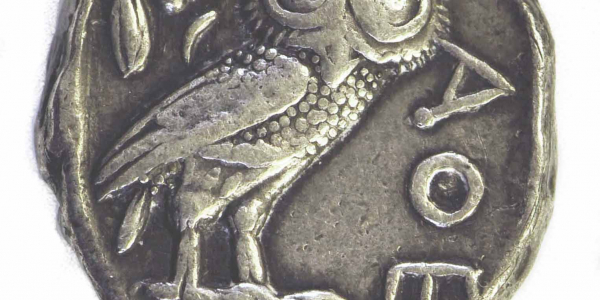As per my last entry in Beyond the Collection, the mistake of assuming that what is common, damaged, worn, or otherwise uninteresting is also or therefore unimportant may be most egregious when it applies merely to the condition of a surviving coin. Coinages which circulated heavily in commerce tend not to be represented in collections by many, if indeed any, pristine examples, so if we were to examine a coinage in relationship to circulation then the worn examples may end up telling us far more about the coinage than the pristine ones ever could. What pristine condition does allow us to see is what was intended for a particular coin or whole series prior to its issue, whether this concerns iconography and type or weight and purity of metal and so on, but we should also keep in mind that pristine coins did not circulate and thus may have performed different functions once issued.
Many of the most important coinages ever issued easily fit the bill of common, worn, or poorly made and such features are often intelligible as the result of mass production, sometimes under duress. Good examples of that include what I, for one, had long been tempted to view as eminently dull coins, or at least coins from which we probably could not learn much that was genuinely new, namely, the Athenian tetradrakhmai minted during the height of the Athenian arkhê, c. 454 to 404 BC. These coins were issued in such huge, perhaps inestimable quantities that they can be found in abundance in collections of every size and description, often as the sole representative of Greek coins altogether if the collection is focused on something quite modern or different, like U.S. issues of the twentieth century. A coin of Athens from the age of Perikles, the Parthenon, and Athens’ great war with the Spartans and their allies (the Peloponnesian War, 431- 405 BC), after all, has timeless appeal.
The types are seemingly so familiar that they would hardly need to be repeated: the obverse bears an archaic image of Athena, helmeted, facing to the right and adorned with earring and necklace; her helmet bears a palmette and three olive leaves, most striking is her eye, which is rendered almost as if the goddess were looking frontally at us; the reverse bears the goddess’ owl, which does face us, but is accompanied by the abbreviated ethnic of the Athenians (ΑΘΕ in Attic script for ΑΘΗΝΑΙΩΝ), and a sprig of olive with fruit that seems to point to what most take to be the crescent moon that appeared on the night before the Athenians and their allies faced, and defeated, the great Persian fleet at Salamis in 480 BC.
A recent examination of a large number of these coins through photographs allowed me to see them in a new light. Even though the familiar elements such as the three leaves upon Athena’s helmet or the shape of her earring seem unchanging, I began to see slight, sometimes telling, differences from one coin to another even there once I adjusted my eyes to start looking at the coins as individual objects and not as identical products of something like an ancient factory. My purpose, I should note, was not to carry out any research per se—there was nothing that I was looking for explicitly—but rather to make good on a promise (made to myself) to look anew at coins that I was accustomed to look past—it was merely a conscientious exercise in trying to be a good numismatist. What I found in the sea of almost monotonous sameness made up by great quantities of Athenian tetradrakhmai, however, rewarded my effort in surprising ways.
One element which caught my attention was that the die-cutters used several different drills or sizes of drill bits, with which to render everything from the owl’s plumage to the Athena’s necklace. Athena’s necklace, for instance, is almost always rendered with three large dots, while what seem to be rivets on her helmet are rendered in a smaller size, and so on. But how many dots are there, or, how many times did a die-cutter use the drill to cut any sized dot into the reverse or obverse die?
Starting with high quality good photographs, chosen at random, of four well-struck, centered, well-preserved specimens that were struck using different dies early in the life of those dies but otherwise simply typical of the coinage as a whole, I enlarged the photographs and printed them out, which enabled me then to count the dots created by those drills. The shadows created by the sculptural relief of these coins is hard to work around, and perhaps it would have been more productive to work with the Wulfing coins in the vault (if only there was no pandemic!). Coin A yielded at least 70 dots on the obverse and 62 on the reverse; Coin B yielded 67 and 62, respectively. Examination of two other coins yielded less useful results but are still interesting (C: 57+, 87; D: 46+, 69). Counting Athena can be quite difficult because the plaits of her hair or part of her helmet crest are usually off of the coin, are not fully struck, or exhibit much die wear, hence the low obverse counts on Coins C and D; but the parts that can be examined produce very similar numbers to those areas on coins whose design and die-state are most conducive to this kind of exercise.
Where it is possible to count the dots, we can see some range in the number but this, I think, is mostly a function of the size of the drill bit. The owl’s body on D has only some 33 dots, but they appear to be a bit larger and are slightly more spaced out than on C, for instance, where they appear quite jumbled and are slightly smaller. Smaller drill size translates into more frequent use of the drill if the object is to create the same impression of texture in the owl’s plumage, for example. All in all, if we take these four coins as randomly representative of the coinage, then a die-cutter would probably need to use the drill over 60 times for each die (and, it seems, the obverse die would need just a few more dots than the reverse).
While we should be impressed by the sheer labor and skill required to manipulate the drill that frequently over the highly concave surfaces in the dies that the die-cutter was creating, there is another lesson that might also be drawn. Quality-control at every level, from the die-cutter himself to various overseers at the mint and, ultimately, the Athenian dêmos itself produced a high-functioning system that could produce enormous quantities of these coins at rapid pace and use dies that had to be hand-drilled and hand-cut to a remarkably uniform standard. We know nothing about this system except for the coins that it produced. How were the dies examined and by what specific criteria were they judged? How often were dies rejected? What was the exact model that the die-cutters used?
There are many more questions that should be asked of these coins, and perhaps if we look closely enough and with enough intelligence, they may surrender a few of their secrets. These coins are common and easy to overlook precisely because they played such a significant role in the events of their time and continued to play a role in commerce and daily life for generations thereafter. Old, worn, abused, corroded, seemingly uninteresting, common coins very much deserve a new eye, now and far into the future—after all, they were the stuff of commerce and war on a large scale. So, let us now take another look at whatever at first glance seems dull, worn, abused, or simply too common to waste time upon as exactly what we should be spending our time exploring.


